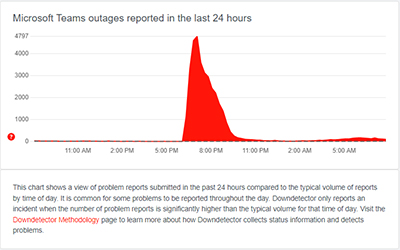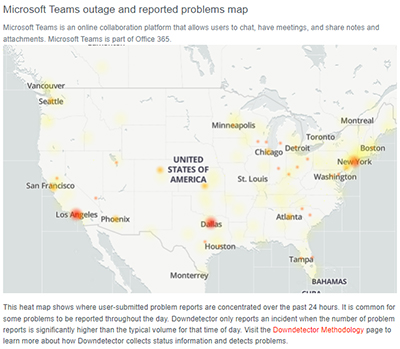News
Microsoft Teams Hit with a 6-Hour Outage
- By Kurt Mackie
- July 21, 2022
Microsoft has confirmed that its Microsoft 365 apps and Teams services were down for some users on Wednesday night.
Update 7/22: Exoprise, a company that offers performance-monitoring solutions to detect service outages, estimated that the July 20 Microsoft Teams outage lasted three hours, per
this blog post.
The July 20 outage was briefly addressed publicly by Microsoft in this Twitter post series, which suggested that it occurred because of "a broken connection to an internal storage service." The outage affected "multiple Microsoft 365 services with Teams integration, such as Microsoft Word, Office Online and SharePoint Online."
Microsoft referred people seeking further information on the outage to its Office status portal (http://status.office.com), or to messages in its Message Center. Both venues, though, are just accessible to IT administrators of Microsoft 365 services. Even those IT pros may have been thwarted, as Microsoft also admitted that "some users have reported that they are unable to access the admin center to view updates."
The inability for administrators to see information about service downtimes has been a recurring issue associated with Microsoft services over the years, and it continued in this case.
The time estimate of six hours of downtime for Teams and other services is just a guess, as Microsoft didn't offer a chronology. It's based on complaints recorded by Downdetector.com, which showed a spike in Microsoft Teams complaints starting at about 6:00 p.m. on July 20, which tapered toward zero at around 11:00 p.m. on that same day (see chart):
 [Click on image for larger view.] Figure 1. Graph of complaints about the Microsoft Teams service on July 20 (source: Downdetector.com).
[Click on image for larger view.] Figure 1. Graph of complaints about the Microsoft Teams service on July 20 (source: Downdetector.com).
Microsoft didn't indicate in its public Twitter announcements where the outages took place. However, per Downdetector.com, it seems to have mostly affected U.S. users in Los Angeles, Dallas and New York City (see chart):
 [Click on image for larger view.] Figure 2. Heatmap of the Microsoft Teams outage on July 20 (source: Downdetector.com).
[Click on image for larger view.] Figure 2. Heatmap of the Microsoft Teams outage on July 20 (source: Downdetector.com).
Places such as Hong Kong and Eastern Australia also may have been affected by the Teams outage, based on comments found in Microsoft's Twitter announcement.
Microsoft does have a nuanced service level agreement associated with its cloud services. Based on it, organizations can only get a service-time credit in compensation for any downtime. Moreover, they have to apply for the service credit, as it's not automatically applied.
Microsoft's service outage elicited a comment from Mark Boost, CEO of Civo, a U.K.-based provider of managed Kubernetes services, who suggested via e-mail that big cloud service providers, such as Microsoft, don't offer organizations any better assurances of stability.
"Last night's major Microsoft 365 and Teams outage is a reminder of the fallibility of even the largest cloud providers," Boost said. "The assumption that brand familiarity and scale alone are enough to maintain uptime is continually challenged by outages of this kind."
Boost added that complexity just increases with hyperscale cloud service providers, such as Microsoft, "where the deployment of a storage device caused services used by billions across the globe to be unusable."
He suggested that the cloud services industries could do a lot better than they have been doing on a number of fronts.
"Outages sit alongside unpredictable billing, complex services, and other issues that shackle users," Boost said. "As an industry we need to forge a new status quo, one focused on delivering streamlined, reliable, and fast cloud services -- all for a fair and transparent price."
About the Author
Kurt Mackie is senior news producer for 1105 Media's Converge360 group.